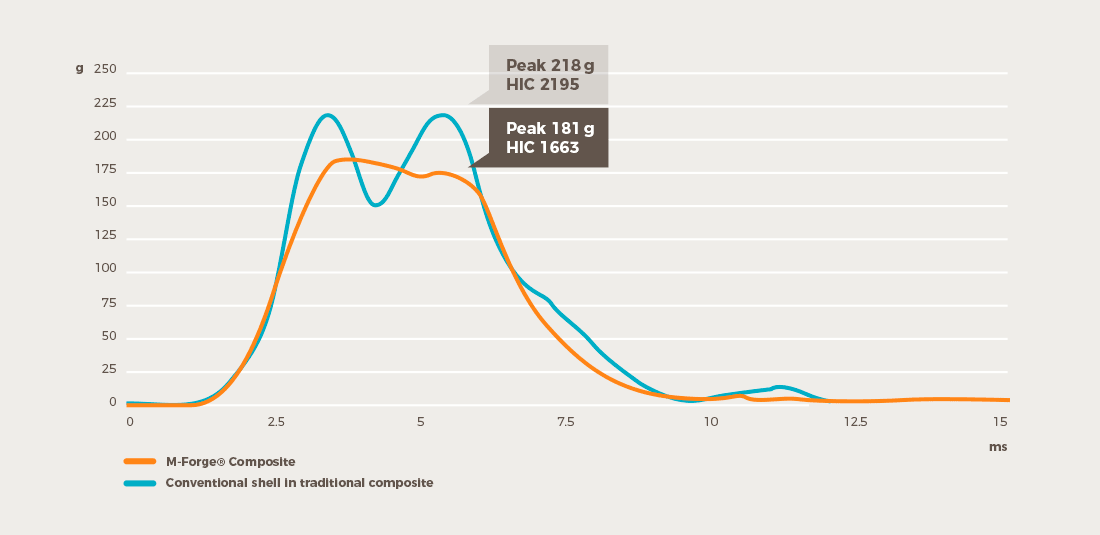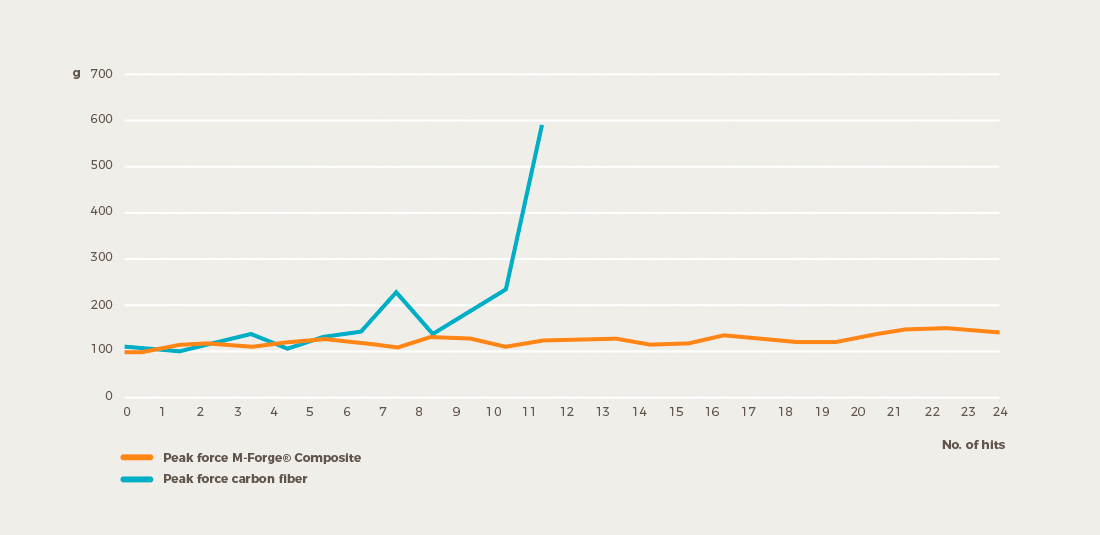M-Forge® Composite is a material technology platform specifically developed for hard shell products applications, which combines the best characteristics of the best polymer and fibre shells.
PATENTED TECHNOLOGY
M-Forge® technology applied on a motorcycle helmet

Lightweight

Excellent impact performance

Fracture resilience to multiple impacts

Reduced rebound

Weatherability

Eco-friendly
LIGHTWEIGHT: WEIGHT SAVINGS
M-Forge® Composite shells have 10% to 40% lower weights than comparable materials depending on product type, country-standard and helmet dimension.
M-Forge® Composite Technology is exceptional for any product that needs to protect you from impact and in activities where minimum weight gives you a performance advantage.
M-Forge® Composite helmets pass multiple country standards with a single low weight shell. Examples:
Motorcycle helmets: ECE 2205, DOT FMVSS218, SNELL M2010, AS-NZ, JIS, NBR and other country standards
Bicycle helmets: EN1078, ASTM F1952 and other country standards
Ski & Snow helmets: EN1077, ASTM F2040
IMPACT PERFORMANCE
M-Forge® Composite Technology delivers superior safety through improved impact attenuation performance compared to top-end carbon fibre materials, and with a lighter shell weight.
— View Study —
COMPARISON IMPACT CURVES

M-Forge® Composite increases safety over traditional helmet shell materials
This graph compares two equivalent impacts in a helmet with M-Forge® Composite Talisman series shell (ORANGE) vs. a helmet with conventional FIBREGLASS composite (BLUE).
Both tests are according to Reg. UNECE-ECE22.05 standard specification, and represent an exact comparison where every test condition and helmet specification is exactly the same, except the shell, one being M-Forge® Composite (ORANGE) and the other conventional FIBREGLASS composite (BLUE).
The impact test conditions are: 62 cm head-form, top-highest possible position impact (P point as per ECE 22.05), against a flat-shaped anvil (mimicking a flat ground), helmet previously conditioned at -20ºC. Those test conditions are typically the most challenging for energy absorption, and often conventional helmets strive to meet the HIC threshold criteria.
HIC accounts for “Head Injury Criterion”, this being a very well established mechanical parameter based in the height and amplitude of the acceleration pulse, which correlates with the likelihood to suffer a head injury and its intensity, as standardized by means of the AIS system (Abbreviated Injury Scale): The higher the HIC, the higher chances to suffer serious or fatal injuries.
In the case of the standard used here, ECE 22.05, both the maximum acceleration (amax) and HIC are the parameters used to assess the performance of a helmet under impact, with threshold values of amax<275 and HIC<2400.
The results show a better performance for the helmet having an M-Forge® Composite shell, which would mean a reduced severity of the likely injuries suffered by a biker under an equivalent accident.
The reason is the intrinsic nature of the M-Forge® Composite material: Given M-Forge® Composite uses a thermoplastic matrix instead the conventional thermosets, it behaves with increased ductility and tenacity: The shell deforms more before any fracture happens, and thanks to that the system can be designed so that MORE of the impact kinetic energy is transformed into “deformation work” of the shell and EPS through mechanical hysteresis. In other terms, as the shells behaves “more plastic” or “less elastic” than the benchmark, the bounce back after the hit (rebound speed) is reduced, and therefore the difference of initial and end speed is smaller, so that it can be managed with a smaller deceleration, which obviously determines the value of the maximum acceleration and HIC.
REPEATED IMPACT PERFORMANCE
One of the many attributes of the M-Forge® Composite Technology is its superior performance compared to other materials for repeated impacts. The impact-absorbing properties of the material diminish at a far slower rate when compared to other materials in the market, thus allowing M-Forge® products to perform better.
— View Study —
REPEATED IMPACT ABSORTION DATA

Comparison of impact absorption as per ASTM F1952 (Down-Hill helmets) between a CARBON Fibre shell (BLUE) and a M-Forge® Composite shell (ORANGE).
The CARBON Fibre shell, when submitted to multiple repeated impacts in reduced speed (75%), withstands up to 11 hits, with a recorded acceleration within limits, although increasing steadily. After that, the whole shell structure is too much damaged to sustain the 12th impact, which causes a catastrophic impact test result, well beyond the 300g threshold of the standard.
Comparing to that, the M-Forge® Composite shell is capable to withstand more than 24 hits without relevant damage to the shell and, thus, is capable to deliver a safety performance always well below 200g.
M-Forge® helmets have best-in-class low energy repeat impact resistance, especially important for motocross helmets, downhill mountain bike helmets and other sports activities, where minor falls and impacts are to be expected.
ADDITIONAL BENEFITS

Reduced rebound
M-Forge® Composite shell rebounds less than comparable materials. That reduces deceleration forces.

Weatherability
M-Forge® Composite helmets are temperature stable and exceed the extreme temperature condition requirements of each different product type and related standard/norm.

Eco-friendly
M-Forge® Composite Technology uses clean* manufacturing, and M-Forge® Composite shells are recyclable**.
* Volatile Organic Compound (VOC) free
** ![]()
MATERIAL EVOLUTION
M-Forge® Composite Technology includes a family of composite materials built in different yarns, weavings and fabrics, and different processes, in different specifications and performances, to match the structural design requirements for each typology of product and/or market/segment.
New materials are under development to continually increase the added value of M-Forge® Composite in demanding applications. The range of M-Forge® Composite materials includes four different “Series”:
M-FORGE® TALISMAN SERIES
The core material series delivering excellent lightweight performance and toughness.
M-FORGE® VANGUARD SERIES
A series of materials bringing increased flexural rigidity, further weight reduction and increased surface hardness.
M-FORGE® PEGASUS SERIES
A series delivering the absolute maximum performance to weight ratio.
M-FORGE® AERO SERIES
A new series of material enabling in-moulding for ultra-lightweight hard-shells construction.
TECHNOLOGY PLATFORM EVOLUTION
Since a successful introduction into motorcycle and sportshelmets industry, M-Forge® Composite Technology is being applied to a wide range of hard-shells applications in sports and professional personal protective equipment.

Sports
Mountain biking, ski, mountaineering, horse riding, skydiving, football…

Professional PPE
Firemen, police forces, army corps, construction workers…

Other hard-shell products
Ski boots, travel suitcases…






